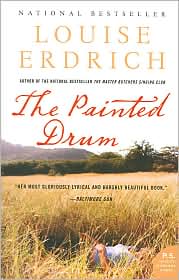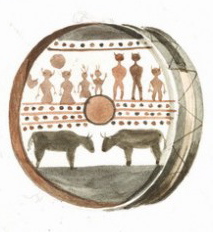“Some people believe objects absorb something of their owner’s essence. I stay clear of that. And yet, when I step near the drum, I swear it sounds. One deep, low, resonant note. I stop dead still, staring at the drum. I hear it, I know I hear it, and yet Sarah Tatro does not.”
When Faye T ravers, an estate agent in New Hampshire, inventories the home of John Jewett Tatro at the behest of his niece and heirs, she is aware that Tatro’s grandfather was once an Indian agent on an Ojibwe reservation and that his grandmother was Indian. Faye, of Indian heritage herself, is hoping to find some Indian artifacts that can be sold or donated to a museum on behalf of the estate. Sarah Tatro, the niece, is not much interested in “old beadwork and stuff,” and she has almost forgotten the old storage room in the attic, but when she opens it, Faye finds a room packed with suitcases containing beadwork, baskets, moccasins and other handwork, a cradleboard, and a beaded footstool—a collection of enormous value.
ravers, an estate agent in New Hampshire, inventories the home of John Jewett Tatro at the behest of his niece and heirs, she is aware that Tatro’s grandfather was once an Indian agent on an Ojibwe reservation and that his grandmother was Indian. Faye, of Indian heritage herself, is hoping to find some Indian artifacts that can be sold or donated to a museum on behalf of the estate. Sarah Tatro, the niece, is not much interested in “old beadwork and stuff,” and she has almost forgotten the old storage room in the attic, but when she opens it, Faye finds a room packed with suitcases containing beadwork, baskets, moccasins and other handwork, a cradleboard, and a beaded footstool—a collection of enormous value.
Neither Faye nor Sarah Tatro notices the drum, at first—three feet in diameter, hollowed out from a single piece of cedar wood and covered by a moose hide. Suddenly, the drum “speaks” to Faye, resonating with a single, deep note which only she hears.

The story of the “Little Girl” drum (with no spoilers here) takes the reader from Faye’s life and love story in New Hampshire to an Ojibwe reservation in Minnesota. Bernard Shaawano, the grandson of the man who made the drum, has been contacted by a judge, the nephew of old Nanapush, who informs him that the drum has returned to the reservation.
As Bernard narrates the history of the drum in Part II, he tells the stories of his grandfather and grandmother Anaquot on the reservation, explaining why his grandfather made the drum, what he was memorializing, and how this drum eventually came into the possession of John Jewett Tatro in New Hampshire. The fascinating process by which the drum was made, the ceremonies and traditional beliefs accompanying it, and the traumatic lives and deaths of the Shaawano family over three generations connect the drum and its history with the essence of Ojibwe life and death.
In th e third part of the novel, Shawnee, a young girl living in a remote area of the reservation, is left babysitting for her younger brother and baby sister on a bitterly cold night in which they have not enough fuel and no food. Their mother has gone to town for help, but she gets sidetracked drinking, leaving the children alone for several days. The depiction of the lives of the children is heart-rending, and their connection to the “Little Girl Drum” adds another layer of mystery to the drum’s “life.”
e third part of the novel, Shawnee, a young girl living in a remote area of the reservation, is left babysitting for her younger brother and baby sister on a bitterly cold night in which they have not enough fuel and no food. Their mother has gone to town for help, but she gets sidetracked drinking, leaving the children alone for several days. The depiction of the lives of the children is heart-rending, and their connection to the “Little Girl Drum” adds another layer of mystery to the drum’s “life.”
Written with a homey intimacy and honesty, Erdrich brings the reader into the lives of her characters, real people with real faults and real conflicts. Generous in her assessment of their characters, she does not make value judgments about them, showing instead the circumstances which have led them to behave as they do–for better or worse–and how they are all connected through the drum. Nature, which intimately affects the lives and deaths of these characters, is further emphasized through the many symbols and repeating motifs—a field of orb spiders, jewelweed, a dog which escapes its cruel confines, wolves and their mystical connection with mankind. Always, of course, Erdrich conveys Indian spiritual values, even as she depicts their often sad and limited lives. 
Tightly organized, with stories spanning three generations and interconnecting three different families—Faye Travers and her mother Elsie, Bernard Shaawano, and Shawnee and her mother Ira— The Painted Drum is a powerful novel which taps into universal feelings and hopes, even as it depicts some of life’s most terrible events. (On my Favorites list for 2005)
ALSO by Louise Erdrich: SHADOW TAG, THE ROUND HOUSE, LAROSE, THE SENTENCE
Notes: The author’s photo by Orin Rutchick of Minneapolis/St. Paul appears here: http://www.mspmag.com
The first photograph here of an Objibwe painted drum is described as an “Octagonal Painted Frame Drum, an Ojibwe Hand drum used for personal and social occasions. Painting of stylized bird on rawhide head, and other designs usually triangular in nature; relatively thick wooden frame wrapped on outside with white rawhide decorated with beading in groups of three.” It may be seen here: http://unegawaya.blogspot.com
The watercolor and pencil drawing of a ceremonial Ojibwe drum is in the Royal Ontario Museum: http://unegawaya.blogspot.com
